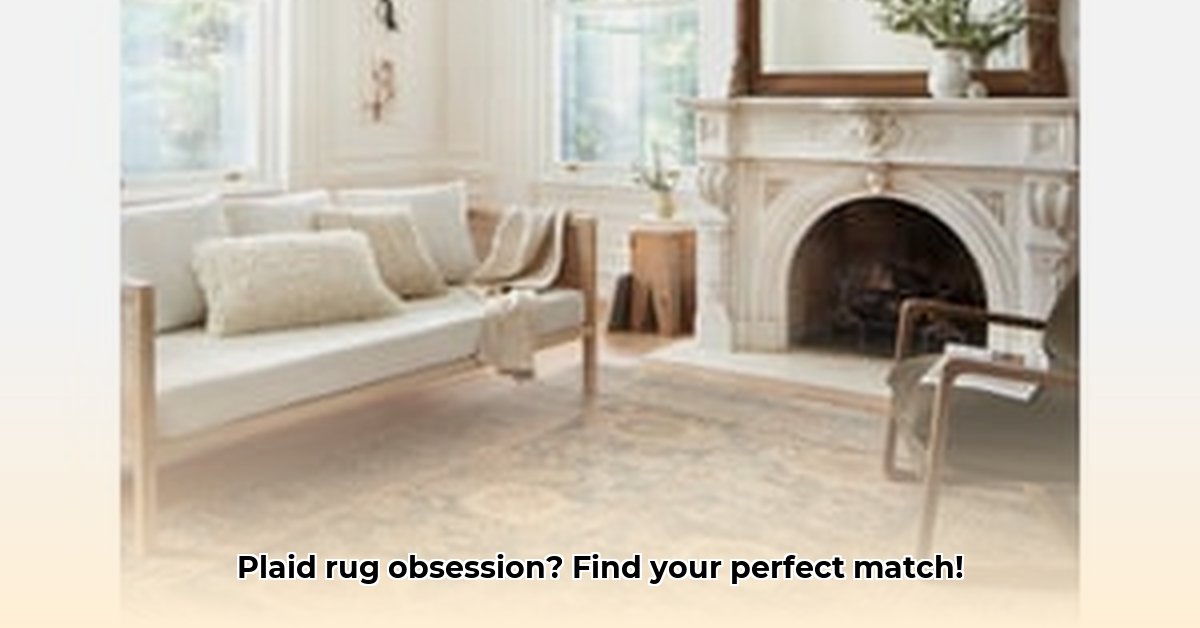Plaid rugs are versatile, adding a touch of classic style to any room. But with so many options, choosing the right one can be challenging. This guide provides the information needed to find the perfect plaid rug, from measuring your space to selecting the right material and maintaining its appearance. For even more rug options, check out these round braided rugs.
Finding Your Perfect Plaid Rug: A 2025 Guide
Picking out the perfect plaid rug can feel overwhelming, but it’s manageable with the right information. Plaid rugs are incredibly versatile, adding charm to farmhouse kitchens and modern living rooms. This guide breaks down the process, making it easy to find the ideal rug for your space and elevate your home decor.
Measuring Your Space: Getting the Size Just Right for Plaid Rugs
Before browsing plaid patterns, accurate measurements are essential. Proper measurements are key for selecting the right plaid rug. Determine if you want the rug to anchor your furniture, creating a defined area. Measure the space and add 18 to 24 inches to extend beyond the furniture, creating a balanced look without feeling cramped. A smaller rug might be the perfect accent piece to highlight an area in your room. A rug that’s too small can look lost, while one that’s too big can make a room feel smaller.
Understanding Rug Plaid Sizes: Finding the Perfect Fit
Standard rug sizes vary, and choosing the right one depends on the room and its purpose. A 2′ x 3′ rug works in a narrow entryway or as a pop of color in a bathroom. Larger rugs, like 8′ x 10′ and beyond, suit living rooms, creating a comfortable anchor for your seating. Dining rooms often require larger rugs to allow chairs to be pulled out without scraping the floor. Bedrooms benefit from rugs that extend beyond the sides of the bed.
Here’s a guide to help you visualize the perfect plaid rug size:
| Room Type | Recommended Rug Size(s) | Considerations |
|---|---|---|
| Entryway | 2’x3′, 3’x5′ | Relatively small to maintain flow. |
| Living Room | 5’x8′, 8’x10′, 9’x12′ | Size of the seating area. |
| Dining Room | 6’x9′, 8’x10′, 9’x12′ | Chairs can be pulled back easily. |
| Bedroom | 5’x8′, 6’x9′ | Size of your bed and other furniture. |
These are suggestions; the perfect size for your room depends on other factors, such as traffic and furniture size.
Material Matters: Choosing the Right Fiber for Your Plaid Rug
The material of your rug is crucial for its durability, ease of cleaning, and overall feel. Wool rugs are soft and luxurious, offering warmth and insulation but often require professional cleaning and can be more expensive. Jute rugs, made from a natural plant fiber, are durable and eco-friendly, but they’re more likely to stain and might require more care. Synthetic fibers, such as polypropylene, are less expensive and easy to clean, making them an excellent option for high-traffic areas or homes with children and pets. They’re often resistant to stains. If you suffer from allergies, consider hypoallergenic options, like synthetic rugs. Always check the care instructions before purchasing.
Style & Color Selection: Finding the Perfect Plaid Pattern and Color
Plaid rugs offer an incredible variety of colors and patterns. A classic red buffalo check adds rustic charm, while subtle, muted plaids complement contemporary or minimalist designs. Bold geometric plaids can make a statement, creating a focal point. When selecting colors, consider your existing furniture and wall colors. The rug should complement the overall design. A well-chosen rug ties the entire room together. Coordinating colors help unify your interior design. Popular choices include:
- Buffalo Check: A large, bold check, often in red and black or black and white.
- Tartan: A traditional Scottish pattern with intersecting stripes of different colors.
- Gingham: A simple, woven check pattern, typically in white and a color like blue or pink.
- Windowpane: A large, simple check pattern resembling window panes.
Cleaning and Care: Keeping Your Plaid Rug Looking Its Best
Cleaning depends on the material. Vacuum regularly, especially in high-traffic areas, to remove dust and dirt and extend its life. For spills, act quickly. Blot spills with a clean cloth to prevent them from setting. Some rugs are machine washable. Check the care label before washing, as incorrect washing techniques may damage the rug fibers. For delicate rugs, such as wool or silk, professional cleaning is often the best option. A rug pad underneath can protect the rug from damage, prevent slipping, and add cushioning.
How to Choose the Right Size Plaid Area Rug for My Living Room
Key Takeaways:
- Accurate measuring is crucial for selecting the right rug size.
- Understanding standard rug sizes maximizes style.
- The material impacts durability, maintenance, and overall cost.
Step 1: Measure Your Space – The Foundation of Rug Selection
Before thinking about plaid patterns, accurate measurements are paramount. Measure your living room and where your furniture will sit. Visualize your sofa, armchairs, and coffee table. Will the rug go under all the furniture, or just partially? Use painter’s tape to outline potential rug placement on the floor. This helps avoid mistakes and ensures a cohesive design.
Step 2: Decoding Rug Sizes: Finding Your Perfect Fit
The “perfect” size depends on your space and furniture arrangement. A small rug in a large room looks lost; a giant rug in a small room feels overwhelming. Here’s a quick guide:
| Rug Size (ft) | Suitable for | Notes |
|---|---|---|
| 5×7 | Small living rooms, bedrooms | Works well under a sofa or bed. |
| 6×9 | Medium living rooms | Accommodates a small sofa and chairs. |
| 8×10 | Larger living rooms | Fits most seating arrangements comfortably. |
| 9×12 | Very large living rooms | Ideal for larger spaces with ample furniture. |
Careful consideration ensures the plaid rug serves as a design centerpiece.
Step 3: Material Matters: Durability and Aesthetics Hand-in-Hand
The rug’s material significantly impacts its performance and longevity. Here’s a breakdown:
Wool:
* Pros: Luxurious, durable, naturally stain-resistant.
* Cons: Expensive, may require professional cleaning.
Jute:
* Pros: Eco-friendly, budget-friendly, adds texture.
* Cons: Can be rough, prone to shedding, not as durable as wool.
Synthetic Fibers (Polyester, Nylon):
* Pros: Affordable, stain-resistant, easy to clean.
* Cons: May not be as soft or durable as natural fibers.
Consider your lifestyle and the room’s traffic when choosing a material. A high-traffic area needs a durable material, while a less-used space allows for softer options.
Step 4: Style and Color Selection: Integrating Plaid into Your Living Room
Selecting the right pattern and color is crucial to achieve the desired aesthetic. A bold plaid in vibrant colors works well in a contemporary living room. Subtle, muted plaids create a calming atmosphere in a farmhouse-style space. Consider your existing color palette and the overall style of your room. Use online visual tools to “try before you buy” and ensure your rug aligns with your design vision.
Step 5: Cleaning and Care: Preserving Your Plaid Investment
Read the care instructions carefully; this will vary depending on the material. Many synthetic rugs are machine washable; wool and jute usually require professional cleaning. Regular vacuuming is essential to remove dirt and prevent matting. Address spills immediately with a clean cloth.
- Modern Kitchen Backsplash Ideas To Inspire Your Refresh - December 19, 2025
- Modern Backsplash Ideas: A Guide to Todays Kitchen Trends - December 18, 2025
- Ceramic Kitchen Wall Tiles: Style and Protection for Your Walls - December 17, 2025









